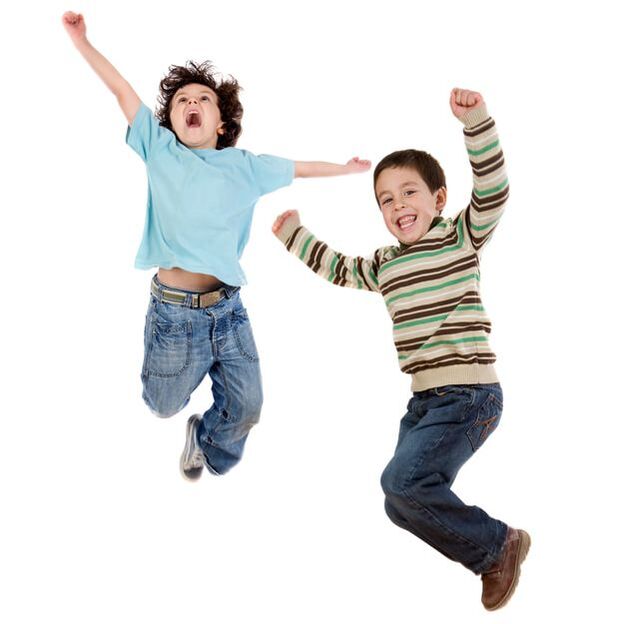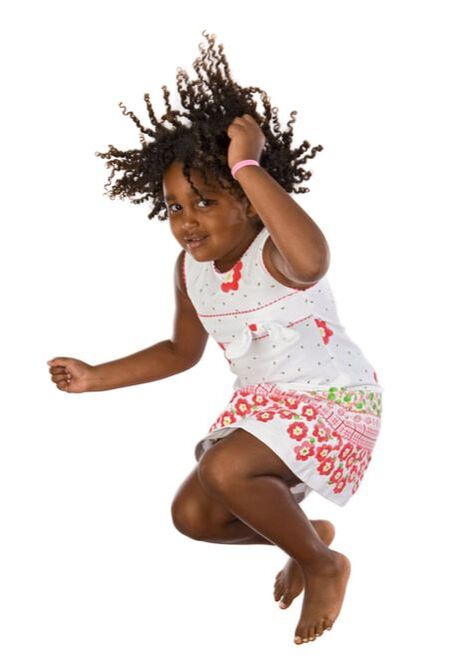Benefits of Physical Activity for Young ChildrenMovement activities are a fun way for children to improve their physical health and development. They benefit children’s learning and behavior, too! Children who are more active are better at self-regulation, so they exhibit fewer behavioral problems. They do better in school and can pay attention longer. They sleep better and are less likely to feel stressed or depressed. Active children have improved confidence in themselves and get along better with their peers. Of course, physical activity develops gross motor skills, builds strong muscles and bones, and improves strength, endurance and flexibility. How much physical activity do children need?
For school-age children, DHHS recommends 60 minutes or more of moderate to vigorous physical activity (MVPA) each day. This should include:
Active Games from A to ZHere are some fun movement activities and games I've found. Try some with your children today! “Action Alphabet” – Act out a movement for each letter of the alphabet A – Act like an alligator B – Bend your knees C – Climb a ladder D – Dance E – Eat your lunch F – Fly like a bird G – Gallop like a horse H – Hop like a bunny I – Ice skate J – Jumping jacks K – Kick a soccer ball L – Leap in the air M – March like a solider N – Nod your head O – Open your arms P – Pop like popcorn Q – Quietly tip toe R – Run in place S – Swim like a fish T – Touch your toes U – Unlock a door V – Vacuum the floor W – Wiggle your body X – Make an “X” with your body Y – Yo-yo up and down Z – Zigzag across the floor (adapted from Physical Activity Card 3 at https://healthykidshealthyfuture.org/) “My Bonnie Lies Over The Ocean” (Stand up or sit down on each “B” word.) My Bonnie lies over the ocean, Bring back, bring back, My Bonnie lies over the sea, O bring back my Bonnie to me, to me. My Bonnie lies over the ocean, Bring back, bring back, O bring back my Bonnie to me. O bring back my Bonnie to me. (various sources) “Car And Driver” - Stand behind a child with your hands on his or her shoulders. Direct the child to stop and start using only your hands. The child can take a turn “driving” you, putting their hands on your waist. (various sources) “Echo! Be my Echo!” - The leader creates a clapping pattern, children listen and repeat. (various sources) Freeze Dances - These were favorites of the children in my classes: Rock and Roll Freeze Dance” by Hap Palmer, and “The Freeze” by Greg & Steve. Of course, you can play freeze dance with any music you start and stop! “Green Means Go…Fast!”- Hold up different color signs. Children walk at the speed of your sign: Green – fast; yellow - regular pace; blue - slow motion, red – stop. Try different locomotor skills – running in place, marching, jumping, galloping, etc. (Action Based Learning) “Hula Hoop Hopping” - Children follow directions to hop in and out of hoops on the ground. Vary your vocabulary: Inside, outside; Next to, beside; etc. (Adapted from Get Moving Today Calendar at https://healthykidshealthyfuture.org/) “I Spy” - Say, “I spy __________” When children see something that fits the criteria they run to it. Each time direct them to use a different type of movement. (healthykidshealthyfuture.org/) “Jump Over the River” - Put two ropes on the floor to make the riverbanks. Let the children jump over the river. Make it a little bigger as you pretend it rains, then jump again. When the river gets too big to jump across, go swimming! (healthykidshealthyfuture.org/) Kick a Ball - Direct children to kick the ball in different directions. (healthykidshealthyfuture.org/) “Leaping on Lily Pads” - Put non-skid lily pad shapes on the floor and label the each one with a color or shape. A child leaps to the one you call out, pushing off with one leg and reaching with the other. (healthykidshealthyfuture.org/) “Mixed Up Body Parts” - The leader calls out body parts for the children to touch but creates one “mix-up” rule - For example, for “head” kids should touch their toes instead. Create one rule to start. (The leader calls out “knees, head, elbow” kids should touch their knees, TOES and elbow). Continue adding other rules to change body parts. (various sources) Number Games – Move a certain way a small number of times. (various sources) Obstacle Course – Set up things for children to jump over, go around, and move under. (various sources) Pretending – Here are some of my children's favorite CDs: Pretend by Hap Palmer and Late Last Night by Joe Scruggs, Quiet Stretches and Slow-motion Movements- Turn on some slow, quiet music; lie on the floor, relax and breathe. (https://www.youtube.com/watch?v=AwgzdJWNwJY) “Ready, Set, Show!” - Play like Paper, Rock, Scissors – have children show numbers, then have them add the numbers together or tell which is more. (Action Based Learning) Skate on Paper Plates - Stand with each foot on a paper plate, slide to the music. (various sources) “A Tooty Ta Ta” - Here's one source: https://www.youtube.com/watch?v=PXvh08Mnork Using a balloon, practice volleying with different parts of your body. Can you keep the balloon in the air using your hand, your thumb, or even your elbow? (healthykidshealthyfuture.org/) Vroom, vroom! Children take turns pulling or pushing other children in a box or basket. Call out different directions for them to go. (healthykidshealthyfuture.org/) Walk, Stop, Melt! - Leader calls commands, including stopping while melting so children can freeze into different poses. (healthykidshealthyfuture.org/) X marks the spot! - Mark a place for children to move to. Direct them to move in different ways. Yoga poses – Here's one source for “Bug Yoga” http://yoga.lovetoknow.com/Kids_Free_Downloadable_Yoga_Videos Zip Zap Zop - Stand in a circle. Someone begins by pointing to another person in the circle and saying "ZIP!" That person then points to yet another person and says "ZAP!“ That person points to another person and says "ZOP!" This continues, but the words must be said in order: ZIP, ZAP, ZOP. (www.teampedia.net) I hope this list of active games gave you some ideas for fun movement activities with your children. Please share your ideas as well! ReferencesNemours Children's Health System. Heathy kids, healthy future. (n.d.) https://healthykidshealthyfuture.org/
U.S. Department of Health and Human Services. Physical Activity Guidelines for Americans, 2nd edition. Washington, DC: U.S. Department of Health and Human Services; 2018. https://health.gov/sites/default/files/2019-09/Physical_Activity_Guidelines_2nd_edition.pdf Texas Health and Human Services Commission. (2021). Texas Minimum Standards for Child-Care Centers. https://www.hhs.texas.gov/sites/default/files/documents/doing-business-with-hhs/provider-portal/protective-services/ccl/min-standards/chapter-746-centers.pdf Torbert, M. (2005). Using active group games to develop basic life skills. Young Children 60(4): 72-78. Torbert, M. & Schneider, L. B. 1993. Follow me too: A handbook of movement activities for three- to five-year-olds. Washington, DC: NAEYC.
0 Comments
Your comment will be posted after it is approved.
Leave a Reply. |
AuthorI'm Diane Goyette, a Child Development Specialist, Trainer, Consultant and Keynote Speaker. I'm excited to share my blog! Archives
August 2023
Categories
All
|
|
Ways to Contact Us:
Schedule an Appointment |
|
Follow earlychildhoodspecialties for encouragement, teaching tips and more!
|
Follow eepworm for child-friendly posts!
|
© 2013-2024 Early Childhood Specialties LLC. All rights reserved.



 RSS Feed
RSS Feed